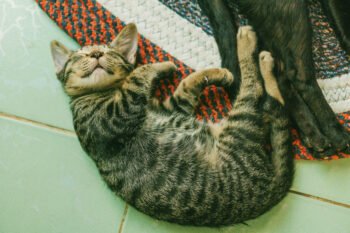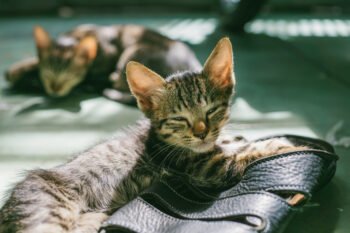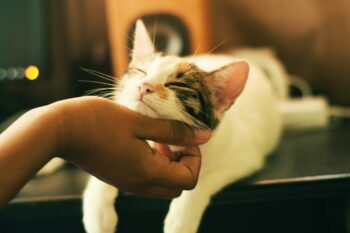Moving away from the “one plan fits all” idea of feline vaccinations, the American Association of Feline Practitioners and the Academy of Feline Medicine Advisory Panel on Feline Vaccinations recently issued a report that says each cat’s vaccination needs should be evaluated individually, based on the cat’s age, health, and circumstances.
The report encourages cat owners to discuss their cat’s vaccination schedule with their veterinarian. Together, owner and veterinarian must consider whether the cat is likely to come in contact with other animals who may spread disease, acquire parasites that may harbor an illness, or live in an area where a specific disease is known to be widespread.
The report discourages the use of polyvalent vaccines (that is, a single injection that contains the vaccine for more than one illness), other than those containing combinations of FPV, FHV-1 and FCV (more on these in a moment), because these combination vaccines “may force practitioners to administer vaccine antigens not needed by the patient.” In addition, the report concluded that “as the number of antigens in a vaccine increases, so too does the probability of associated adverse events.” In other words, the more vaccines given in a single shot, the greater the risk of a bad reaction.
When it comes to adverse events, perhaps none has caused more concern for cat owners than vaccine-associated sarcomas. The report says, “Although vaccine-associated sarcomas have been reported to develop in association with administration of a variety of vaccines, current data suggests they are more frequently associated with administration of feline leukemia virus vaccines and adjuvanted rabies virus vaccines.” (An adjuvant is a substance that is added to increase the efficacy of the vaccine.) Rabies vaccines are now available that do not use adjuvants, but the report says it has not yet been established that these new vaccines will reduce the likelihood of cats developing vaccine-associated sarcoma.
Here are the report’s specific recommendations on the use of currently available feline vaccines:
- Feline panleukopenia (FPV, also called feline distemper): Highly recommended for all cats. A booster should be administered one year after the first vaccination, then no more than every three years. Interestingly, research so far indicates that immunity is sustained for at least seven years after vaccination. However, the research is not definitive, and the report recommends a three-year interval for now, even though no FPV vaccines are approved for this interval.
- Feline viral rhinotracheitis and feline calicivirus (FHV-1 and FCV, which cause upper respiratory diseases): Highly recommended for all cats. A booster should be administered one year after the first vaccination, then once every three years-although again, the currently available vaccines are only approved for annual use. Research so far indicates that vaccine protection lasts at least three years. However, vaccines can only induce an immune response that lessens the severity of the disease-they do not offer complete immunity. In addition, the FCV vaccines that are currently available probably do not induce protection from all forms of the virus.
- Rabies: Highly recommended for all cats. Manufacturers are required by the USDA to establish a minimum duration of immunity for rabies vaccines, and there are products available that are labeled for use every year and others that are labeled for use every three years. The frequency and type of rabies vaccination your veterinarian may administer is often governed by state and local laws.
- Feline leukemia virus (FeLV): “The decision to vaccinate an individual cat against FeLV infection should be based on the cat’s age and its risk of exposure,” says the report. Vaccination is recommended for cats at risk, such as those allowed to roam outdoors and those living in shelters, in households with many cats or where new cats are introduced frequently. However, it is not recommended for cats who have little or no risk of being exposed to other infected cats. FeLV vaccines also do not induce protection against the disease in all cats, so preventing exposure to infected cats is still the best way to prevent FeLV. If vaccination is deemed appropriate, annual revaccination is recommended.
- Feline infectious peritonitis (FIP): There is still a lot of controversy about whether the vaccine that is currently available actually provides protection from this disease. Since the vaccine has not yet been proven beneficial, it is not recommended.
- Chlamydiosis: Because this upper respiratory disease is not severe and most cats can be treated, and because the adverse events associated with the use of the vaccine are relatively high, routine vaccination is not recommended.
- Dermatophytosis (also known as ringworm, although it is a fungal skin infection): Vaccination has not been demonstrated to prevent infection or to eliminate the disease-causing organisms from infected cats, so routine vaccination is not recommended. It is used primarily to help treat difficult cases.
- Bordetella bronchiseptica (another respiratory infection): The efficacy of this vaccine has not been independently evaluated, and how often to revaccinate has not yet been determined. Routine vaccination is not recommended, but it is reasonable to consider vaccinating cats in environments where the infection is present.
- Giardiasis (an intestinal parasite): Routine vaccination is not recommended. However, infected cats who were vaccinated had less severe signs of the disease and were contagious for a shorter period of time, so vaccination may be considered where there has been significant exposure to the protozoan that causes the disease.
The vaccine against feline immunodeficiency virus (FIV) had not yet been announced when this report was published. This past March, the United States Department of Agriculture (USDA) approved an FIV vaccine for commercial production and veterinary use. It’s likely the vaccine will be available by the end of this year. The veterinarians we spoke to said how effective the vaccine is, how often revaccination may be recommended, and whether it causes any adverse reactions remain to be seen. Meanwhile, the best way to protect your cat against FIV is to keep him indoors.
|
To read the complete report of the American Association of Feline Practitioners and the Academy of Feline Medicine Advisory Panel on Feline Vaccinations, visit the related websites.
To learn more about vaccine-associated sarcoma in cats, visit American Veterinary Medical Association website. |







